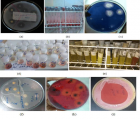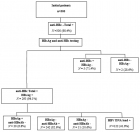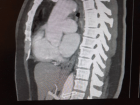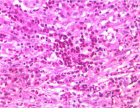Abstract
Research Article
Isolation and biochemical characterization of Plant Growth Promoting (PGP) bacteria colonizing the rhizosphere of Tef crop during the seedling stage
Zerihun Tsegaye*, Birhanu Gizaw, Genene Tefera, Adey Feleke, Solomon Chaniyalew, Tesfaye Alemu and Fasil Assefa
Published: 28 March, 2019 | Volume 3 - Issue 1 | Pages: 013-027
The use of novel PGPR as bio inoculant is an alternative sustainable agricultural practice to improve soil health, grain quality, increase crop productivity, and conserve biodiversity. The aim of this study is to isolate, and characterized PGP bacteria colonizing tef rhizosphere during the seedling stage. For this concern, 426 samples of tef (Eragrostis tef) rhizosphere soils and roots were collected from East Shewa zone, Oromia regional state. 200 morphologically different bacterial pure colonies were isolated and screened for their PGP traits and biocontrol properties. Among these 40.5% isolates were positive for phosphate solubilization. 36% were positive for IAA production, 4.5% were positive for ammonia production, 19 % were positive for (EXPS), 15.5% were positive for protease production, 12.5% were positive for HCN productions, 9.5 % were positive for cellulase production, 4% were positive for amylase production, 3.5% were positive for chitinase production. For abiotic stress tolerance test, all of the isolates were grown well at 20oc and 30oc and neutral pH, 27% isolates were grown well at 4oc, 25.5% grew at 40oc, 25.5% were grown well on pH-9 and pH-11, 23.5% were tolerated pH-5, 3.5% grew at 50oc and 60oc, 13.5% were grown well on 5% NaCl (w/v), 3.5% were grown well on 10 and 15% NaCl (w/v), which indicated these isolates can survive in some extreme conditions. Totally 15 bacterial species having PGP traits, biocontrol properties, and abiotic stress tolerance ability were identified using the Biolog bacterial identification system. Among these, the majority of the identified PGPR have utilized carbohydrate, carboxylic acid, and amino acid, which are the main components of plant root exudates. The above results indicated that thus PGPR can be used as biofertilizers as well as biocontrol agents to replace agrochemicals to improve crop productivity. Hence, these species can be further formulated and used for greenhouse and field applications.
Read Full Article HTML DOI: 10.29328/journal.jpsp.1001027 Cite this Article Read Full Article PDF
Keywords:
Biolog; Plant growth promoting rhizobacteria; Tef; Rhizosphere; Rhizoplane
References
- Tsegaye Z, Assefa F, Tefera G, Alemu T, Gizaw B. Characterization and Identification of Tef (Eragrostis tef) Seed Endophytic Bacterial Species and Evaluate their Effect on Plant Growth Promotion. J Plant Pathol Microbiol. 2018; 9: 438-446. Ref.: https://goo.gl/ykMZ8j
- Ketema S. Tef [Eragrostis tef (Zucc.) Trotter]. Promoting the Conservation and Use of Underutilized and Neglected Crops 12. Institute of Plant Genetics and Crop Plant Research, Gatersleben/International Plant Genetic Resources Institute, Rome, Italy. 1997; 52. Ref.: https://goo.gl/5UMGqZ
- Jansen GR, DiMaio LR, Hause NL. Amino acid composition and lysine supplementation of tef. J Agric Food Chem. 1962; 10: 62-64. Ref.: https://goo.gl/rRfbFH
- Ketema S. Tef (Eragrostis tef): breeding, genetic resource, agronomy utilization and role in Ethiopia agriculture. Institute of Agricultural Research, Addis Ababa. 1993; 147. Ref.: https://goo.gl/24rvxV
- Zeleke G, Agegnehu G, Abera D, Rashid S. Fertilizer and soil fertility potential in Ethiopia: Constraints and opportunities for enhancing the system. IFPRI, Addis Ababa Ethiopia. 2010; 63. Ref.: https://goo.gl/DLkph3
- CSA (Central Statistical Agency). Agricultural Sample Survey 2008-2013 Vol. 1. Report on area and production for major crops (private peasant holding meher season) statistical Bulletin. Addis Ababa, Ethiopia. 2008.
- Bekele, E. A review of research on diseases of barley, tef and wheat in Ethiopia. 79- 08. In: Abate T. (ed.) A review of crop protection research in Ethiopia. Proceedings of the first Ethiopian crop protection symposium, 4-7 February. 1985, Addis Ababa, Ethiopia IAR, Addis Ababa, Ethiopia. 1985. Ref.: https://goo.gl/kwd62A
- Vandana UM, Chopra A, Choudhury A, Adapa D, Mazumder PB. Genetic diversity and antagonistic activity of plant growth promoting bacteria, isolated from tea-rhizosphere: a culture dependent study. Biomedical Res. 2018; 29: 853-864. Ref.: https://goo.gl/52qUST
- Muleta D, Assefa F, Granhall U. In vitro antagonism of rhizobacteria isolated from Coffea Arabica L. against emerging fungal coffee pathogens. Eng Life Sci. 2007; 7: 1-11. Ref.: https://goo.gl/drhikn
- Farina R, Beneduzia A, Ambrosinia A, de Camposa SB, Lisboab BB, et al. Diversity of plant growth-promoting rhizobacteria communities associated with the stages of canola growth. Appl Soil Ecol. 2012; 55: 44–52. Ref.: https://goo.gl/wScGyG
- Husen E. Screening of soil bacteria for plant growth promoting activities in vitro. J Agric Sci. 2005; 4: 27–31. Ref.: https://goo.gl/kZKznn
- Vessey JK. Plant growth promoting rhizobacteria as biofertilizers. Plant-soil. 2003; 255: 571–586. Ref.: https://goo.gl/CCCajt
- Alquéres S, Meneses C. Rouws L. Rothballer M. Baldani I, et al. The bacterial superoxide dismutase and glutathione reductase are crucial for endophytic colonization of rice roots by Gluconacetobacter diazotrophicus PAL5. Mol Plant Microbe Interact. 2013; 26: 937-945. Ref.: https://goo.gl/1bg9bL
- Carvalhais LC, Dennis PG, Fan B, Fedoseyenko D, Kierul K, et al. Linking plant nutritional status to plant-microbe interactions. PLoS One. 2013; 8: e68555. Ref.: https://goo.gl/jL9gjP
- Gorfu D, Ahmed E. Crops and Agro-ecological Zones of Ethiopia. Ethiopian Institute of Agricultural Research. Unpublished Document. 1996. Ref.: https://goo.gl/FbKCAq
- Gemechu D. Aspects of climate and water budget in Ethiopia. Addis Ababa University Press. 1977; 76. Ref.: https://goo.gl/adVn7s
- Pikovskaya RE. Mobilization of phosphorus in soil in concentration with vital activity of some microbial species. Microbiologiya. 1948; 17: 362-370. Ref.: https://goo.gl/C2C3v3
- Trivedi MK, Patil S, Tallapragada RM. Effect of biofield treatment on the physical and thermal characteristics of vanadium pentoxide powders. J Mater Sci Eng. 2013; 11: 001. Ref.: https://goo.gl/kdvT5M
- Brick JM, Bostock RM, Silverstone SE. Rapid in situ assay for indole acetic acid production by bacteria immobilized on the nitrocellulose membrane, Appl Environ Microbial. 2004; 57: 535-538. Ref.: https://goo.gl/N2bsdL
- Castric PA. Hydrogen cyanide, a secondary metabolite of Pseudomonas aeruginosa. Can J Microbiol. 1975; 21: 613-618. Ref.: https://goo.gl/8iCuGv
- Bakker AW, Schippers B. Microbial cyanides production in the rhizosphere inrela-tion to potato yield reduction and Pseudomona sspp. Mediated plant growth stimulation. Soil Microbiol Biochem. 1987; 19: 451–457. Ref.: https://goo.gl/gta2ur
- Chang WT, Hsieh CH, Hsieh HS, Chen C. Conversion of crude chitosan to an anti-fungal protease by Bacillus cereus. World Journal of Microbiology and Biotechnology. 2009; 25: 375–382. Ref.: https://goo.gl/rru6s7
- Khianngam S, Pootaengon Y, Techakriengkrai T, Tanasupawat S. Screening and identification of cellulase-producing bacteria isolated from oil palm meal. J App Pharm Sci. 2014; 4: 090-096. Ref.: https://goo.gl/nwucT6
- Gupta R, Gigras P, Mohapatra H, Goswami VK, Chauhan B. Microbial α-amylases: a iotechnological perspective. Process Biochem. 2003; 38: 1599-1616. Ref.: https://goo.gl/1KNB8u
- Roberts WK, Selitrennikoff CP. Plant and bacterial chitinases differ in antifungal activity. J Gen Microbiol. 1988; 134: 169-176. Ref.: https://goo.gl/Pkx4VF
- Morgan MC, Boyette M, Goforth C, Sperry KV, Greene SR. Comparison of the Biolog OmniLog Identification System and 16S ribosomal RNA gene sequencing for accuracy in identification of atypical bacteria of clinical origin. J Microbiol Methods. 2009; 79: 336-343. Ref.: https://goo.gl/KiSh3j
- Naseem H, Bano A. Role of plant growth-promoting rhizobacteria and their exopolysaccharide in drought tolerance of maize. Journal of Plant Interactions. 2014; 9: 689-701. Ref.: https://goo.gl/9Ehp4X
- Tsegaye Z, Assefa F, Beyene D. Properties and application of plant growth promoting rhizobacteria. Int J Curr Trend Pharmacobiol Med Sci. 2017; 2: 30-43. Ref.: https://goo.gl/fA4aFd
- Liu M, Liu X, Cheng BS, Ma XL, Lyu XT, et al. Selection and evaluation of phosphate-solubilizing bacteria from grapevine rhizospheres for use as biofertilizers. Spanish Journal of Agricultural Research. 2016; 14: 6144-9714. Ref.: https://goo.gl/wXin4C
- Dasgupta D, Sengupta C, Paul G. Screening and identification of best three phosphate solubilizing and IAA producing PGPR inhabiting the rhizosphere of Sesbania bispinosa. International Journal of Innovative Research in Science, Engineering and Technology. 2015; 4: 3968-3979. Ref.: https://goo.gl/HGyJuz
- Habib SH, Kausar H, Saud HM, Ismail MR, Othman R. Molecular Characterization of Stress Tolerant Plant Growth Promoting Rhizobacteria (PGPR) for Growth Enhancement of Rice. Int J Agric Biol. 2015; 18: 184–191. Ref.: https://goo.gl/HhaKCG
- Patten CL, Glick BR. Bacterial biosynthesis of indole-3-acetic acid. Can J Microbiol. 1996; 42: 207-220. Ref.: https://goo.gl/1wk81p
- Carrillo AE, Li CY, Bashan Y. Increased acidification in the rhizosphere of cactus seedlings induced by Azospirillum brasilense. Naturwissenschaften 89. 202; 428-432. Ref.: https://goo.gl/KGpHcK
- Naher UA, Radziah O, Halimi MS, Shamsuddin ZH, Razi MI. Effect of root exuded specific sugars on biological nitrogen fixation and growth promotion in rice (Oryza sativa). Aust J Crop Sci. 2011; 5: 1210-1217. Ref.: https://goo.gl/aXzBgr
- Upadhyay SK, Singh JS, Singh DP. Exopolysaccharide-producing plant growth-promoting rhizobacteria under salinity condition. Pedosphere. 2011; 21: 214–222. Ref.: https://goo.gl/6z4Hp1
- Parida SK, Das AB. Salt tolerance and salinity effects on plants. Ecotoxicol Environ Safety. 2005; 60: 324–349. Ref.: https://goo.gl/6JrSCq
- Berg G. Plant-microbe interactions promoting plant growth and health: perspectives for controlled use of microorganisms in agriculture. Appl Microbiol Biotechnol. 2009; 84: 11–18. Ref.: https://goo.gl/d6VvWp
- Devi R, Thakur R. Screening and identification of bacteria for plant growth promoting traits from termite mound soil. Journal of Pharmacognosy and Phytochemistry. 2018; 7: 1681-1686. Ref.: https://goo.gl/fAkr13
- Zahid M, Abbasi MK, Hameed S, Rahim N. Isolation and identification of indigenous plant growth promoting rhizobacteria from the Himalayan region of Kashmiran their effect on improving growth and nutrient contents of maize (Zeamays L.). Front Microbiol. 2015; 6: 207. Ref.: https://goo.gl/7j4a7D
Figures:

Figure 1

Figure 2

Figure 3
Similar Articles
-
Impact of Calcium Phosphate Nanoparticles on Rice PlantHrishikesh Upadhyaya*,Lutfa Begum,Bishal Dey,P K Nath,S K Panda. Impact of Calcium Phosphate Nanoparticles on Rice Plant. . 2017 doi: 10.29328/journal.jpsp.1001001; 1: 001-010
-
Antagonistic features displayed by Plant Growth Promoting Rhizobacteria (PGPR): A ReviewMohsin Tariq*,Muhammad Noman,Temoor Ahmed,Amir Hameed,Natasha Manzoor,Marriam Zafar. Antagonistic features displayed by Plant Growth Promoting Rhizobacteria (PGPR): A Review . . 2017 doi: 10.29328/journal.jpsp.1001004; 1: 038-043
-
Isolation and biochemical characterization of Plant Growth Promoting (PGP) bacteria colonizing the rhizosphere of Tef crop during the seedling stageZerihun Tsegaye*,Birhanu Gizaw,Genene Tefera,Adey Feleke,Solomon Chaniyalew,Tesfaye Alemu,Fasil Assefa . Isolation and biochemical characterization of Plant Growth Promoting (PGP) bacteria colonizing the rhizosphere of Tef crop during the seedling stage. . 2019 doi: 10.29328/journal.jpsp.1001027; 3: 013-027
-
Asynchronous flowering in clonal seed orchards - An effective strategy for alternative managementSoma Mondal*,Ashutosh Srivastava,Geeta Joshi,HC Yashavantha Rao. Asynchronous flowering in clonal seed orchards - An effective strategy for alternative management . . 2019 doi: 10.29328/journal.jpsp.1001029; 3: 036-041
-
Avermectins: The promising solution to control plant parasitic nematodesMohamed S Khalil*,Dalia M Darwesh. Avermectins: The promising solution to control plant parasitic nematodes. . 2019 doi: 10.29328/journal.jpsp.1001036; 3: 081-085
-
In vitro and preventative field evaluations of potential biological control agents and synthetic fungicides for control of Clarireedia jacksonii sp. nov.Robert A Kerr*,Jeffery W Marvin,Lambert B McCarty,William C Bridges,S Bruce Martin,Christina E Wells. In vitro and preventative field evaluations of potential biological control agents and synthetic fungicides for control of Clarireedia jacksonii sp. nov.. . 2020 doi: 10.29328/journal.jpsp.1001043; 4: 001-008
-
A Perspective on therapeutic potential of weedsVikrant Arya*,Ranjeet Kaur Parmar. A Perspective on therapeutic potential of weeds. . 2020 doi: 10.29328/journal.jpsp.1001050; 4: 042-054
-
Food applications of Aloe species: A reviewAdamu Tizazu Yadeta*. Food applications of Aloe species: A review. . 2022 doi: 10.29328/journal.jpsp.1001070; 6: 024-032
-
A look at polyploidy and plant breedingJesica Iannicelli,Alejandro S Escandón*. A look at polyploidy and plant breeding. . 2022 doi: 10.29328/journal.jpsp.1001092; 6: 163-166
-
Phytochemical and pharmacological properties of Jatropha dioicaDiana Isela Araujo-Espino,Blanca Patricia Lazalde-Ramos*,Ana Lourdes Zamora-Perez. Phytochemical and pharmacological properties of Jatropha dioica. . 2023 doi: 10.29328/journal.jpsp.1001098; 7: 010-013
Recently Viewed
-
Various Theories of Fast and Ultrafast Magnetization DynamicsManfred Fähnle*. Various Theories of Fast and Ultrafast Magnetization Dynamics. Int J Phys Res Appl. 2024: doi: 10.29328/journal.ijpra.1001101; 7: 154-158
-
Forest History Association of WisconsinEd Bauer*. Forest History Association of Wisconsin. J Radiol Oncol. 2024: doi: 10.29328/journal.jro.1001071; 8: 093-096
-
Synthesis of Carbon Nano Fiber from Organic Waste and Activation of its Surface AreaHimanshu Narayan*,Brijesh Gaud,Amrita Singh,Sandesh Jaybhaye. Synthesis of Carbon Nano Fiber from Organic Waste and Activation of its Surface Area. Int J Phys Res Appl. 2019: doi: 10.29328/journal.ijpra.1001017; 2: 056-059
-
Obesity Surgery in SpainAniceto Baltasar*. Obesity Surgery in Spain. New Insights Obes Gene Beyond. 2020: doi: 10.29328/journal.niogb.1001013; 4: 013-021
-
Tamsulosin and Dementia in old age: Is there any relationship?Irami Araújo-Filho*,Rebecca Renata Lapenda do Monte,Karina de Andrade Vidal Costa,Amália Cinthia Meneses Rêgo. Tamsulosin and Dementia in old age: Is there any relationship?. J Neurosci Neurol Disord. 2019: doi: 10.29328/journal.jnnd.1001025; 3: 145-147
Most Viewed
-
Evaluation of Biostimulants Based on Recovered Protein Hydrolysates from Animal By-products as Plant Growth EnhancersH Pérez-Aguilar*, M Lacruz-Asaro, F Arán-Ais. Evaluation of Biostimulants Based on Recovered Protein Hydrolysates from Animal By-products as Plant Growth Enhancers. J Plant Sci Phytopathol. 2023 doi: 10.29328/journal.jpsp.1001104; 7: 042-047
-
Sinonasal Myxoma Extending into the Orbit in a 4-Year Old: A Case PresentationJulian A Purrinos*, Ramzi Younis. Sinonasal Myxoma Extending into the Orbit in a 4-Year Old: A Case Presentation. Arch Case Rep. 2024 doi: 10.29328/journal.acr.1001099; 8: 075-077
-
Feasibility study of magnetic sensing for detecting single-neuron action potentialsDenis Tonini,Kai Wu,Renata Saha,Jian-Ping Wang*. Feasibility study of magnetic sensing for detecting single-neuron action potentials. Ann Biomed Sci Eng. 2022 doi: 10.29328/journal.abse.1001018; 6: 019-029
-
Pediatric Dysgerminoma: Unveiling a Rare Ovarian TumorFaten Limaiem*, Khalil Saffar, Ahmed Halouani. Pediatric Dysgerminoma: Unveiling a Rare Ovarian Tumor. Arch Case Rep. 2024 doi: 10.29328/journal.acr.1001087; 8: 010-013
-
Physical activity can change the physiological and psychological circumstances during COVID-19 pandemic: A narrative reviewKhashayar Maroufi*. Physical activity can change the physiological and psychological circumstances during COVID-19 pandemic: A narrative review. J Sports Med Ther. 2021 doi: 10.29328/journal.jsmt.1001051; 6: 001-007

HSPI: We're glad you're here. Please click "create a new Query" if you are a new visitor to our website and need further information from us.
If you are already a member of our network and need to keep track of any developments regarding a question you have already submitted, click "take me to my Query."
























































































































































